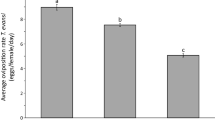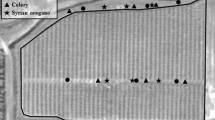Summary
There are three major components to plant structure relevant to searching parasitoids: 1) plant size or surface area, 2) the variation among plant parts (structural heterogeneity), such as seed heads, flowers and nectaries, and heterogeneous surfaces (e.g. glabrous, hirsute), and 3) the connectivity of parts or plant form (structural complexity). We examined the effect of structural complexity, while controlling for size and structural heterogeneity, on searching behaviors of Trichogramma nubilale in controlled environments. Females were presented with a structurally simple surface and a structurally complex one. Parasitism rates were 2.9 times higher on simple surfaces than on complex ones. Unexpectedly, when no hosts were present, searching time on simple surfaces was 1.2 times higher than on complex surfaces. This implies that structural complexity per se can affect the giving-up-time of a searching parasitoid. Searching efficiency, however, was the dominant process, and females found hosts on simple surfaces 2.4 times faster than on complex surfaces. Structural complexity can have a dramatic effect on the success of parasitoid search.
Similar content being viewed by others
References
Ables JR, McCommas DW Jr, Jones SL, Morrison RK (1980) Effect of cotton plant size, host egg location, and location of parasite release on parasitism by Trichogramma pretiosum. Southwest Entomol 5:261–265
Banks CJ (1957) The behavior of individual coccinellid larvae on plants. Br J Anim Behav 5:12–24
Bishop YMM, Feinberg SE, Holland PW (1975) Discrete Multivariate Analysis Theory and Practice. MIT press Cambridge Massachusetts p 557
Burbutis PP, Koepke CH (1981) European corn borer control in peppers by Trichogramma nubilale. J Econ Entomol 74:246–247
Evans HF (1976) The searching behavior of Anthocoris confusus (Reuter) in relation to prey density and plant surface topography. Ecol Entomol 1:163–169
Fowler SV (1985) Differences in insect species richness and faunal composition of birch seedlings, saplings and trees: the importance of plant architecture. Ecol Entomol 10:159–169
Gardner SM, Dixon AFG (1985) Plant structure and the foraging success of Aphidius rhopalosiphi (Hymenoptera: Aphidiidae). Ecol Entomol 10:171–9
Gross HR Jr, Lewis WJ, Jones RL, Nordlund DA (1975) Kairomones and their use for management of entomophagous insects: III Stimulation of Trichogramma achaeae, T. pretiosum and Microphlitis croceipes with host-seeking stimuli at time of release to improve their efficiency. J Chem Ecol 1:431–438
Knipling EF, McGuire JU (1968) Population models to appraise the limitations and potentialites of Trichogramma in managing host insect populations. US Dept Agric Tech Bull 1387
Lawton JH (1978) Host-plant influence on insect diversity: the effects of space and time. Symp R Entomol Soc London 9:105–25
Lawton JH (1983) Plant architecture and the diversity of phytophagous insects. Ann Rev Entomol 28:23–29
Lawton JH, Schroder D (1977) Effects of plant type, size of geographical range and taxonomic isolation on number of insect species associated with British plants. Nature 265:137–40
Lewis WJ, Jones RL, Nordlund DA, Gross HR Jr (1975) Kairomones and their use for management of entomophagous insects: II Mechanisms causing increase in rate of parasitization by Trichogramma spp. J Chem Ecol 1:349–360
Moran VC (1980) Interactions between phytophagous insects and their Opuntia hosts. Ecol Entomol 5:153–64
Morrison G, Lewis WJ (1981) The allocation of searching time by Trichogramma pretiosum in host containing patches. Ent Exp Appl 30:31–39
Need JT, Burbutis PP (1979) Searching efficiency of Trichogramma nubilale. Environ Entomol 8:224–227
Nicholson AJ, Bailey VA (1935) The balance of animal populations. Proc Zool Soc London 551–598
Noldus LPJJ, Buser JHM, Vet LEM (1987) Volatile semiochemicals in host-community location by egg parasitoids. Proc Europ Workshop Parasitoid Insects (Lyon France)
Pimentel D (1961) An evaluation of insect resistance in broccoli, brussels sprouts, cabbage, collards and kale. J Econ Entomol 54:156–8
Price PW (1980) Evolutionary biology of parasitoids. Princeton Univ Press, New York, p 237
Price PW, Bouton CE, Gross P, McPheron BA, Thompson JN, Weis AE (1980) Interactions among three trophic levels: Influence of plants on interactions between insect herbivores and natural enemies. Ann Rev Ecol Syst 11:41–65
Root RB (1975) Some consequences of ecosystem texture. In: Ecosystem analysis and prediction ed Levin SA. Soc Ind Appl Math Philadelphia 83–97
Strong DR, Levin DA (1979) Species richness of plant parasites and growth form of their hosts. Am Nat 116:770–87
Strong DR, Lawton JH, Southwood TRE (1984) Insects on plants. Blackwell Scientific Publications London, p 309
Tukey JW (1977) Exploratory Data Analysis. Addison-Wesley Reading Massachusetts, p 688
Yu DSK, Laing JE, Hagley EAC (1984) Dispersal of Trichogramma spp (Hymenoptera: Trichogrammatidae) in an apple orchard after inundative releases. Environ Entomol 13:371–374
Author information
Authors and Affiliations
Rights and permissions
About this article
Cite this article
Andow, D.A., Prokrym, D.R. Plant structural complexity and host-finding by a parasitoid. Oecologia 82, 162–165 (1990). https://doi.org/10.1007/BF00323530
Received:
Accepted:
Issue Date:
DOI: https://doi.org/10.1007/BF00323530




